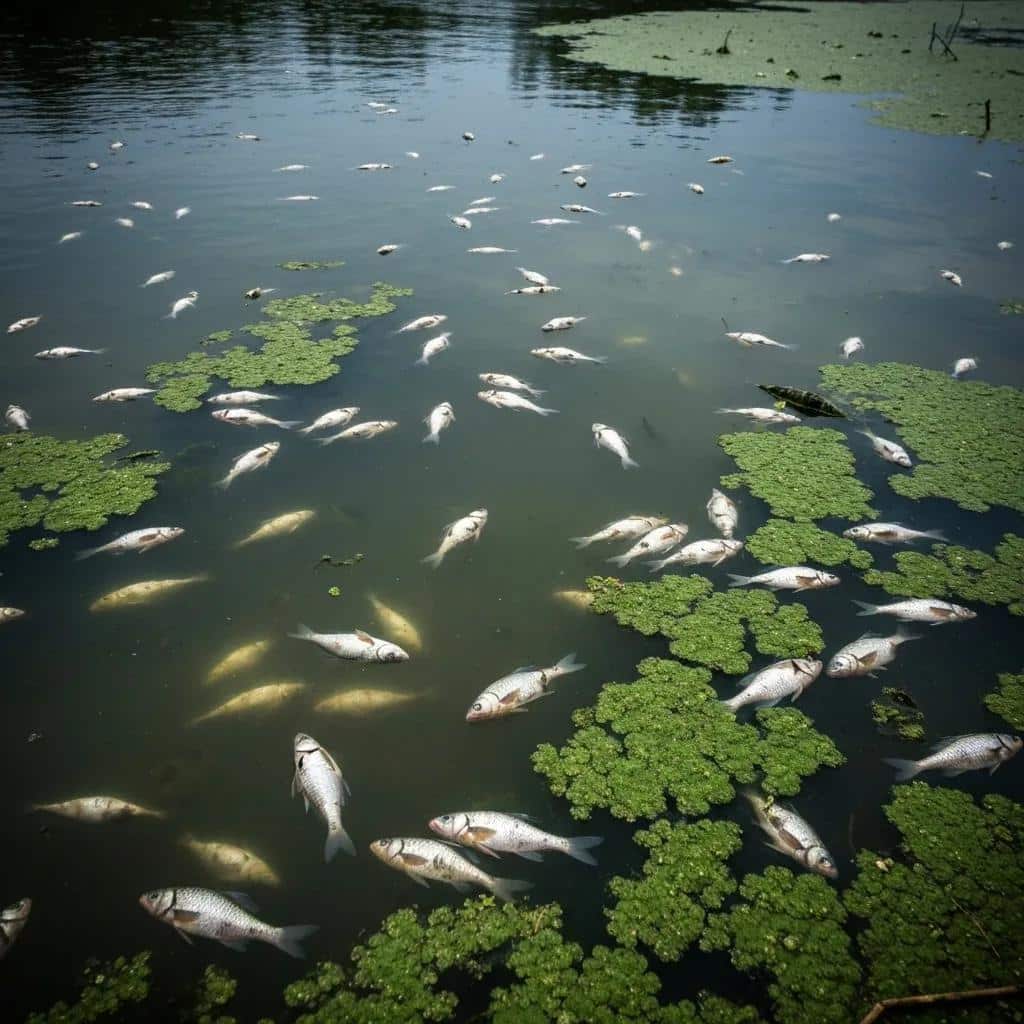The Nitrogen Problem: Understanding and Communicating the Other, Less Talked About Climate Crisis
The dramatic acceleration of reactive nitrogen—now more than double natural rates—constitutes a hidden climate emergency, driving greenhouse gas emissions, water and air pollution, biodiversity loss, and human health risks. Addressing “The Nitrogen Problem” demands not only scientific solutions but clear, persuasive communication that empowers students, professionals, and organizations to act. This article will explain the core issue and its significance, detail environmental and health impacts, identify major emission sources, outline sustainable management strategies, and show how to craft effective advocacy—leveraging AI‐powered writing tools to amplify your message.
What Is the Nitrogen Problem and Why Does It Matter?
Reactive nitrogen refers to bioavailable forms (ammonia, nitrate, nitrous oxide) that persist in the environment and trigger cascading impacts across air, water, soil, ecosystems, and human health. These compounds accumulate primarily through industrial fertilizer production (Haber-Bosch), fossil fuel combustion, and intensive livestock systems. As a potent greenhouse gas, nitrous oxide (N₂O) traps heat approximately 273 times more effectively than CO₂, linking nitrogen pollution directly to climate change, while excess nitrogen in waterways fuels algal blooms and depletes oxygen, threatening aquatic life.
What Is Reactive Nitrogen and How Does It Affect the Environment?
Reactive nitrogen (Nr) comprises ammonia (NH₃), nitrate (NO₃⁻), nitrite (NO₂⁻), and nitrous oxide (N₂O). These compounds enhance plant growth at low levels but, at elevated concentrations, they disrupt natural nutrient cycles, degrade soil, acidify water bodies, and contribute to atmospheric pollution. Because nitrogen travels across ecosystems, its environmental footprint extends well beyond agricultural fields, touching forests, rivers, and urban airsheds.
How Have Human Activities Altered the Natural Nitrogen Cycle?
Industrial fixation via the Haber-Bosch process produces over 100 million tonnes of synthetic fertilizer annually, surpassing natural biological fixation. Combustion of oil, coal, and gas adds oxidized nitrogen (NOₓ) to the atmosphere. Excess nitrogen runoff from farms and urban areas overwhelms aquatic systems. The result is a fundamental imbalance: only 10–15% of applied nitrogen feeds crops, while the remainder pollutes air and water, doubling the global nitrogen input into terrestrial ecosystems compared to pre-industrial levels.
Sustainable Nitrogen Management in Agrifood Systems
A comprehensive report from the Food and Agriculture Organization (FAO) emphasizes that while nitrogen fertilizers have boosted agricultural production, their improper use severely damages air, water, and soil quality, leads to biodiversity loss, and exacerbates climate change. The report notes that human activities now add more than double the pre-industrial rate of reactive nitrogen to the Earth’s land surface annually. It provides recommendations for sustainable nitrogen management, including improving nitrogen use efficiency and adopting circular bioeconomy practices.
This citation verifies the article’s points on the environmental and climate impacts of excessive nitrogen from agriculture, the alteration of the natural nitrogen cycle by human activities, and the need for sustainable management strategies.
Why Is Nitrogen Pollution Considered a Climate Crisis?
Nitrous oxide accounts for roughly 5 percent of anthropogenic greenhouse gas emissions and persists in the atmosphere for over a century. Its high global warming potential amplifies climate forcing, undermining CO₂ reduction gains. Additionally, nitrification and denitrification processes produce NOₓ and ozone precursors that exacerbate warming. Tackling nitrogen pollution is therefore essential for meeting mid-century climate targets and averting catastrophic warming trajectories.
UNEP and FAO Report on Rising Nitrous Oxide Emissions
A joint report by the United Nations Environment Programme (UNEP) and the Food and Agriculture Organization (FAO) highlights the urgent concern over increasing nitrous oxide (N₂O) emissions. The report states that N₂O has a global warming potential 273 times that of carbon dioxide and is a significant ozone-depleting substance. Agriculture is identified as the primary source, accounting for approximately 70% of total N₂O emissions, with substantial opportunities for reduction through proven methods.
This report directly supports the article’s claims regarding nitrous oxide’s potent greenhouse gas effect, its contribution to ozone depletion, and the significant role of agriculture in its emissions.
How Does Nitrogen Pollution Impact Climate, Ecosystems, and Human Health?
Nitrogen disruption manifests in multiple domains—each interlinked through a cascade of environmental transformations that amplify one another and ultimately compromise human well-being.
Impacts of Nitrogen Emissions on Ecosystems and Human Health
A review from Wageningen University & Research details the adverse effects of increased reactive nitrogen inputs on terrestrial and aquatic ecosystems, as well as human health. Key impacts include the loss of plant diversity, excessive algal growth leading to oxygen-deficient “dead zones,” and human health issues from increased concentrations of nitrogen dioxide, ozone, and particulate matter. The review also highlights the risk of nitrate in drinking water, even below regulatory levels.
This research provides verified information supporting the article’s sections on how nitrogen pollution impacts ecosystems (eutrophication, biodiversity loss) and human health (drinking water contamination, respiratory issues).
What Role Does Nitrous Oxide Play in Climate Change?
Nitrous oxide, a byproduct of soil microbial processes and industrial combustion, accelerates global warming by trapping infrared radiation and contributing to stratospheric ozone depletion. It remains in the atmosphere for approximately 114 years, making its cumulative radiative forcing a long-term concern. Reducing N₂O emissions thus delivers immediate and sustained climate benefits.
How Does Nitrogen Cause Eutrophication and Aquatic Dead Zones?
Excess nitrate and ammonium enter rivers and coastal waters, fueling explosive algal growth (algal blooms). When algae die and decompose, they consume dissolved oxygen, creating hypoxic “dead zones” where fish and invertebrates cannot survive.
These dead zones compromise fisheries, reduce biodiversity, and incur economic losses for coastal communities.
In What Ways Does Nitrogen Pollution Degrade Air Quality?
Ammonia emissions from fertilizers react with NOₓ to form fine particulate matter (PM₂.₅), which penetrates deep into lungs and exacerbates respiratory and cardiovascular diseases. NOₓ also generates ground-level ozone, contributing to smog and asthma incidents. Elevated ambient NO₂ levels exceed WHO guidelines in many regions, posing chronic health threats.
How Does Excess Nitrogen Lead to Biodiversity Loss and Ecosystem Disruption?
Nitrogen over-enrichment favors fast-growing, nitrogen‐loving species at the expense of sensitive wildflowers, mosses, and lichens. This shift reduces habitat diversity, undermines food webs, and diminishes pollinator abundance. In forest ecosystems, nitrogen deposition alters soil chemistry, weakening trees and increasing susceptibility to pests and drought.
What Are the Human Health Risks from Nitrogen Pollution?
Elevated nitrates in drinking water carry risks of methemoglobinemia (“blue baby syndrome”) in infants. Airborne NOₓ and PM₂.₅ exacerbate asthma, chronic bronchitis, and cardiovascular events. Globally, an estimated 77 percent of people are exposed to unhealthy NO₂ levels, increasing morbidity and healthcare burdens.
What Are the Main Sources and Pathways of Nitrogen Emissions?
Understanding emission origins allows targeted mitigation across sectors.
How Does Agriculture Contribute to Nitrogen Pollution?
Fertilizer application, manure management, and enteric fermentation from livestock generate ammonia, nitrate leaching, and N₂O. Inefficient nutrient use—often exceeding crop needs—leads to 50–70 percent of applied nitrogen escaping fields into air and water.
What Are the Industrial and Transportation Sources of Nitrogen Emissions?
Combustion of fossil fuels in power plants, vehicles, and manufacturing releases NOₓ into the atmosphere. Industrial processes such as nylon production also emit ammonia and nitric acid, compounding ambient nitrogen loads.
How Do Wastewater and Urban Areas Add to Nitrogen Pollution?
Untreated sewage and stormwater runoff carry organic nitrogen and ammonia into rivers and coastlines. Urban fertilizer use on lawns and golf courses further elevates nitrate concentrations in local waterways.
What Solutions Exist for Sustainable Nitrogen Management and Pollution Reduction?
Mitigation spans improved practices, innovative technologies, policy frameworks, and individual choices.
How Can Sustainable Agriculture Practices Reduce Nitrogen Pollution?
Adopting 4R nutrient stewardship—right source, rate, time, place—optimizes fertilizer use. Cover cropping, buffer strips, and crop rotation enhance soil structure, reduce runoff, and improve nitrogen use efficiency.
What Technological Innovations Help Manage Nitrogen More Efficiently?
Nitrification inhibitors slow the conversion of ammonium to nitrate, reducing leaching and N₂O emissions. Biochar amendments sequester nitrogen in soils, while precision GPS-guided fertilizer applicators match nutrient delivery to plant needs.
How Do Policies and Governance Support Nitrogen Pollution Control?
International agreements (e.g., UNEP nitrogen resolution), national emission standards for NOₓ, and incentives for precision farming foster coordinated action. Regulatory frameworks that cap total nitrogen inputs and fund research accelerate adoption of best practices.
What Individual Actions Can Reduce Your Nitrogen Footprint?
Consumers can choose plant-based diets, reduce food waste, and support sustainably produced crops. Home gardeners can apply organic compost at appropriate rates, plant native species, and install rain gardens to filter stormwater.
How Can You Communicate the Nitrogen Crisis Clearly and Effectively?
Translating complex nitrogen science into accessible narratives drives public understanding and policy support.
How to Write Clear and Persuasive Environmental Reports on Nitrogen?
Begin with succinct definitions—define “reactive nitrogen” and link it to observable impacts. Use data tables and EAV comparisons to show, for example:
Conclude each section with actionable recommendations that guide decision-makers and stakeholders.
Grammarly’s AI‐powered writing assistant ensures clarity, coherence, and tone consistency, helping authors refine technical jargon into reader-friendly prose and maintain confidence across diverse audiences.
What Are Best Practices for Explaining Complex Nitrogen Science to Diverse Audiences?
Use analogies (e.g., “nitrogen behaves like an over-fed sponge that overflows into waterways”), define terms before using acronyms, and vary sentence length for readability. Incorporate infographics and bullet lists to break down multifaceted processes, making information memorable.
How Does Grammarly Support Effective Environmental Advocacy and Communication?
Grammarly accelerates drafting by suggesting precise vocabulary, flagging passive constructions, and aligning tone with audience expectations. Its clarity checks and style enhancements empower writers to present technical data with persuasive force, ensuring arguments about nitrogen solutions resonate with policymakers, funders, and the public.
Frequently Asked Questions
What are the long-term effects of nitrogen pollution on ecosystems?
Nitrogen pollution can lead to significant long-term effects on ecosystems, including biodiversity loss and habitat degradation. Over-enrichment of nitrogen favors fast-growing species, which can outcompete native flora, reducing plant diversity. This shift disrupts food webs and can lead to the decline of pollinators and other wildlife. Additionally, altered soil chemistry from nitrogen deposition can weaken trees and increase their vulnerability to pests and diseases, further destabilizing forest ecosystems over time.
How can individuals contribute to reducing nitrogen pollution?
Individuals can play a crucial role in reducing nitrogen pollution by making conscious choices in their daily lives. Opting for a plant-based diet, minimizing food waste, and supporting sustainably produced food can significantly lower nitrogen footprints. Home gardeners can also help by using organic compost, planting native species, and implementing rain gardens to filter stormwater runoff. These actions collectively contribute to a healthier environment and help mitigate the impacts of nitrogen pollution.
What role do policies play in managing nitrogen emissions?
Policies are essential for managing nitrogen emissions effectively. They can establish regulatory frameworks that set limits on nitrogen inputs, promote sustainable agricultural practices, and incentivize research into innovative technologies. International agreements, such as the UNEP nitrogen resolution, encourage countries to collaborate on reducing nitrogen pollution. By creating standards and providing financial support for best practices, policies can drive significant improvements in nitrogen management across various sectors.
What are the economic implications of nitrogen pollution?
Nitrogen pollution has substantial economic implications, particularly for agriculture and fisheries. Excess nitrogen can lead to eutrophication, resulting in dead zones that harm fish populations and reduce commercial fishing yields. Additionally, the costs associated with water treatment to remove nitrates from drinking water can burden municipalities and taxpayers. The loss of biodiversity and ecosystem services can also impact tourism and recreation, further highlighting the need for effective nitrogen management strategies.
How does nitrogen pollution affect air quality?
Nitrogen pollution significantly impacts air quality through the release of nitrogen oxides (NOₓ), which contribute to the formation of ground-level ozone and fine particulate matter (PM₂.₅). These pollutants can exacerbate respiratory and cardiovascular diseases, posing serious health risks to populations. Areas with high nitrogen emissions often experience smog and poor air quality, leading to increased healthcare costs and reduced quality of life for residents. Addressing nitrogen pollution is thus critical for public health.
What are the challenges in addressing the nitrogen problem?
Addressing the nitrogen problem presents several challenges, including the complexity of nitrogen cycles and the diverse sources of emissions. Coordinating efforts across agricultural, industrial, and urban sectors requires collaboration among various stakeholders, which can be difficult to achieve. Additionally, there may be resistance to changing established practices and policies. Public awareness and understanding of the nitrogen issue are also limited, making effective communication and advocacy essential for driving change.
How can technology aid in nitrogen management?
Technological innovations play a vital role in improving nitrogen management. Tools such as precision agriculture technologies, including GPS-guided fertilizer applicators, help optimize nutrient delivery, reducing excess nitrogen runoff. Nitrification inhibitors can slow the conversion of ammonium to nitrate, minimizing leaching and nitrous oxide emissions. Additionally, advancements in monitoring and data analysis can enhance our understanding of nitrogen dynamics, enabling more effective management strategies and policies to mitigate pollution.
What Is the Nitrogen Problem?
The nitrogen problem is the excessive accumulation of reactive nitrogen forms—ammonia, nitrate, nitrite, nitrous oxide—arising from human activities, causing environmental degradation, climate forcing, and health risks.
How Does Nitrogen Pollution Affect Climate Change?
Nitrogen pollution impacts climate change primarily through nitrous oxide emissions, which have a global warming potential 273 times that of CO₂ and contribute to ozone layer depletion.
What Are the Main Sources of Nitrogen Pollution?
Major sources include agricultural fertilizer application and livestock, fossil fuel combustion in industry and transport, and untreated wastewater discharges from urban areas.
What Are the Solutions to Nitrogen Pollution?
Key solutions involve sustainable farming (4R stewardship, cover crops), technological innovations (nitrification inhibitors, precision farming), regulatory policies, and consumer actions like reducing meat consumption and food waste.
How Does Nitrogen Affect Human Health?
High nitrate levels in drinking water can cause methemoglobinemia in infants, while NOₓ and particulate matter aggravate respiratory and cardiovascular diseases.
What Is Eutrophication and How Is It Caused by Nitrogen?
Eutrophication is nutrient‐driven overgrowth of algae in water bodies, caused by excess nitrogen runoff, leading to oxygen depletion and aquatic die-offs.
How Can Agricultural Nitrogen Runoff Be Reduced?
Runoff can be curtailed by precision fertilizer application, use of cover crops, buffer strips, and adoption of nitrification inhibitors to slow nitrogen leaching.
Where Can You Find Authoritative Data and Case Studies on the Nitrogen Crisis?
What Do UNEP and FAO Reports Say About Nitrogen Pollution?
UNEP’s Frontiers Reports highlight nitrogen’s role in biodiversity loss and climate change, calling for halving environmental nitrogen by 2050. FAO’s guidelines detail best practices for improving nitrogen use efficiency in agrifood systems.
How Have Regional Initiatives Successfully Reduced Nitrogen Runoff?
The Chesapeake Bay Program achieved a 25 percent reduction in nitrogen loads through integrated watershed management, cover cropping, and wastewater upgrades. The Netherlands cut agricultural N₂O emissions by 10 percent via ammonia quotas and precision farming incentives.
Which Academic Research Provides In-Depth Analysis of Nitrogen Impacts?
Studies from Wageningen University & Research, PNAS, and Environmental Science & Technology offer comprehensive analyses of reactive nitrogen trends, ecological consequences, and mitigation efficacy across global regions.
Limiting the nitrogen problem requires scientific innovation, policy alignment, and compelling storytelling. By combining sustainable practices with clear, authoritative communication—supported by AI-powered tools—stakeholders can drive meaningful action, safeguard ecosystems, and secure human well-being in the face of this underrecognized climate crisis.
Addressing the nitrogen problem is crucial for mitigating climate change, protecting ecosystems, and safeguarding human health. By understanding the sources and impacts of nitrogen pollution, individuals and organizations can implement effective solutions that promote sustainability. We encourage you to explore sustainable practices and advocate for policies that reduce nitrogen emissions in your community. Together, we can tackle this hidden climate crisis and foster a healthier planet for future generations.



